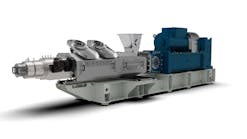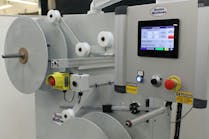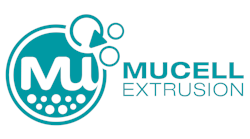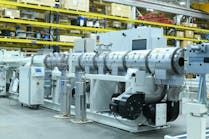Packaging makers are responding to environmental pressures by lightweighting their products and incorporating more recycled plastics and bioplastics, according to Ciaran Little of Smithers. And e-commerce is fueling a transition to flexible packaging, he said.
Little is global VP of business development and director of operations for Asia-Pacific for Smithers, a multinational provider of testing, consulting, information and compliance services. He has spent 20 years supporting the packaging, print and paper value chains with market and technical information in the form of conferences, reports and consulting. His recent projects include a global assessment of printing and packaging growth trends.
Little answered Plastics Machinery & Manufacturing’s questions about packaging trends in an email interview that has been lightly edited for clarity.
What packaging trends has Smithers identified?
Little: Sustainability is a top agenda item for the whole packaging value chain, driven by circular economy principles. Brand owners are responding to consumers’ environmental concerns in several ways, such as reducing plastic packaging use; using more recycled plastics; package lightweighting by reducing material usage without impairing pack performance; and adopting bioplastic packaging. However, packaging performance and cost requirements are also highly important, which creates other sustainability challenges. As a result, the industry has been forming collaborations and partnerships across the value chain, leading to innovation in a bid to achieve sustainability in packaging.
Legislative action is emerging to translate circular economy principles into packaging laws. Flexible packaging, for example, is facing higher taxation, increased EPR [extended producer responsibility] fees, design changes and, in some cases, formal bans.
E-commerce will continue growth into the post-COVID era. Flexible packaging is expected to provide e-commerce solutions either individually or in combination with corrugated packaging. Internet shopping [is] growing at a faster rate after there was a step-change increase in online sales during the pandemic, which was well above the pre-pandemic forecasts. Internet shopping has driven the demand for corrugated board. As sustainability concerns are becoming more important, consumers are demanding e-commerce packaging made from materials that can be readily recycled.
Disruptive influences include the impact of COVID-19, a surge in demand for internet shopping, e-commerce and food delivered to [the] home at the expense of food service. Packaging recycling and sustainability concerns took a back seat during this crisis but should come back to prominence as the pandemic eases. Supply chains for food and drinks markets were disrupted due to trade restrictions, and consumption declined due to lockdown measures imposed by governments globally. This has caused progressively larger fluctuations in demand at the wholesale, distributor, manufacturer and raw material supplier levels.
Massive price hikes in 2021 [occurred] due mainly to forces majeures at many cracker and polymer plants. Converters are short of material and struggle to pass through price hikes to buyers. Many processors have cut back production or closed plants temporarily and faced restricted access to short-term credit facilities to finance working capital. For example, EVOH [ethylene vinyl alcohol] supply in North America continued to stay affected due to shortage of the key feedstock vinyl acetate monomer due to extreme weather conditions.
Are you seeing consumer packaged goods (CPG) brands demand lightweighting?
Little: In the plastics packaging sector, the trend toward greater lightweighting has become a continuous one, although it is debatable as to whether it has reached the equilibrium level of weight and performance. For example, major blow molding machinery producers such as Krones, KHS, Husky and Sidel have continued to develop considerably lighter plastic bottles in recent years.
Any further lightweighting may possibly impact on the packaging’s performance. Nevertheless, continued cost and environmental pressures are encouraging converters to further engage in additional lightweighting.
Are CPG brands demanding more recycled content or content that can be recycled?
Little: Legislation to make post-consumer plastic packaging recyclable or reusable has been proposed in many countries. These plans aim to minimize the complexity of materials — for example, the number of materials and types of plastics used. Many brand owners are committing to 100 percent recyclable packaging by 2025, and all-polyolefin structures have become a major trend. A number of organizations have published guidelines to aid design for recycling, including greater use of mono-materials.
Sustainable packaging incorporates several measures, including package redesign for recycling and waste reduction; making packaging lighter; adopting bioplastic materials; making all plastic packaging reusable, recyclable or compostable; and ensuring that packaging contains recycled materials. The use of recycled materials directly translates into fewer natural resources being used and considerably less energy being consumed when compared to production processes using virgin materials.
What challenges are these changes placing on the packaging supply chain?
Little: With the trend toward packaging recyclability gathering speed, more attention is also being paid to designing the original package to be more easily recyclable. Brand owners and packaging converters are joined by the whole packaging value chain in the efforts to design more sustainable packaging and start with the end in mind.
Design for recycling will play a central role in developing a stronger recycling infrastructure. Producer responsibility will become more of an issue with packaging having to be collected and recycled. Design for recycling gives a critical assessment of current or new designs with advice offered on choice of material and aspects of design.
Contact:
Smithers, Akron, Ohio, 330-762-7441, www.smithers.com/en-gb/services/market-reports/packaging
Bruce Geiselman | Senior Staff Reporter
Senior Staff Reporter Bruce Geiselman covers extrusion, blow molding, additive manufacturing, automation and end markets including automotive and packaging. He also writes features, including In Other Words and Problem Solved, for Plastics Machinery & Manufacturing, Plastics Recycling and The Journal of Blow Molding. He has extensive experience in daily and magazine journalism.
MAS 110 increases throughput
Censco acquiring MuCell Extrusion Technology
KraussMaffei now building extruders in U.S.






